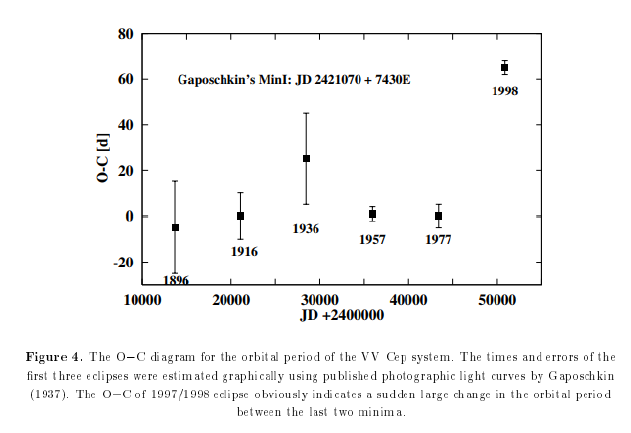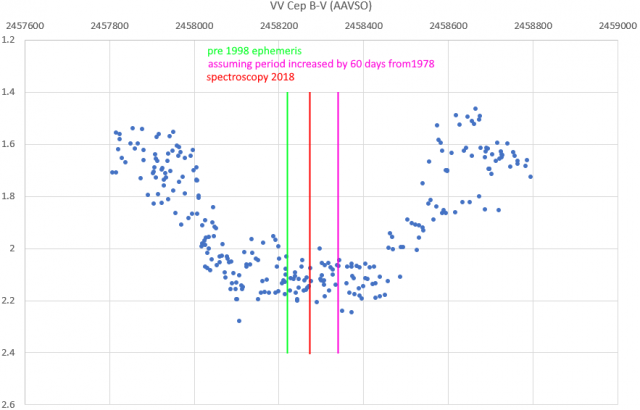› Forums › Variable Stars › VV Cep eclipse paper in JBAA
- This topic has 8 replies, 4 voices, and was last updated 4 years, 4 months ago by
Philip Jennings.
-
AuthorPosts
-
20 August 2021 at 8:50 pm #575031
 Robin LeadbeaterParticipant
Robin LeadbeaterParticipantHugh Allen’s paper on spectroscopy during the eclipse of VV Cep in the latest edition of the Journal is an impressive example of squeezing the maximum information out of a set of low resolution spectra. The period returning to its original value after an apparent increase last time round is puzzling and unless there is enough wriggle room in the uncertainties, could be tricky to explain astrophysically. Are there any theories while we wait for it to come round again ?
Cheers
Robin
21 August 2021 at 4:04 pm #584613 Andy WilsonKeymaster
Andy WilsonKeymasterIndeed an excellent paper by Hugh. Great to see spectra from multiple observers contributing to Hugh’s research on VV Cep.
The shift in central eclipse timing without an apparent long term change in period is a puzzle. It would be interesting to know how accurate the various central timings were over the past hundred years. I wondered whether there was any possibility that different spectral features were used to estimate the central eclipse in early work compared to modern work of the 1990’s and onwards, resulting in a systematic shift in observed in the central time.
Cheers,
Andy
21 August 2021 at 6:01 pm #584615 Robin LeadbeaterParticipant
Robin LeadbeaterParticipantThe argument for something to have happened though between 1978 and 1998 is convincing from fig 4 of the 1999 Graczyk et al paper if the error bars are to be believed
 21 August 2021 at 6:03 pm #584614
21 August 2021 at 6:03 pm #584614 Robin LeadbeaterParticipant
Robin LeadbeaterParticipantHi Andy,
The measurements pre 1997 were all based on the light curves which are indeed tricky to estimate the mid eclipse point from due to the continuing brightness variability of the red giant throughout the eclipse seen in the AAVSO data in fig 5 of Hugh’s paper. The photometry and spectroscopy were in good agreement within 7 days in 1998 though.
I have extracted B-V from the AAVSO data which is less influenced by brightness variations than using using V I think. I have marked Hugh’s spectroscopic mid eclipse and the expected values based both on the earlier ephemeris and assuming a 60 day increase in period post 1978.

Hugh’s value agrees well with the B-V data. The prediction based on a permanent increase in period is clearly not compatible with the current data but perhaps there is enough wriggle room to say that the original ephemeris is ok and the 1997-1998 eclipse data (both spectroscopic and photometric) was anomalous for some reason?
Cheers
Robin
22 August 2021 at 9:46 am #584616 Hugh AllenParticipant
Hugh AllenParticipantHi Robin,
That’s a very convincing B-V curve – so the photometric and spectroscopic eclipse mid-points are in good agreement, like they were also in the two studies I cited in my paper from the late 1997-98 eclipse. Could some variability in the red supergiant be a factor in the changes in the eclipse measurements? It’s hard to understand and makes the next eclipse in 2038 an event to be anticipated!
Cheers
Hugh
22 August 2021 at 10:20 am #584617 Andy WilsonKeymaster
Andy WilsonKeymasterRobin, that is an interesting analysis of the AAVSO data.
I’ve taken a brief look at a couple of the papers and there is mention of different durations of totality. For the 1997-98 Graczyk et al (1999) found totality lasted 450d in U-B and 477d in B-V. While for the 1976-78 Saito et al (1980) found totality lasted just 300d, and Saito note this is “shorter than those estimated during earlier eclipses“.
I’ve not read them in detail, though I wonder if this is a clue to what is happening..
The duration Hugh found is closer to 300d than 450d, at 332d using H-beta. This appears similar to the AAVSO data analysed by Robin, where by eye it looks to be just over 300d.
Cheers,
Andy
22 August 2021 at 11:29 am #584618 Robin LeadbeaterParticipant
Robin LeadbeaterParticipantYes I agree. If the continuous brightness variations are due to radial pulsations of the M star, these would produce changes in the effective radius (and opacity?) of the M star. These could could asymmetrically shift the mid eclipse point dependent on their timing. (is a 50% increase in effective radius due to pulsations feasible?)
Cheers
Robin
22 August 2021 at 11:54 am #584619 Robin LeadbeaterParticipant
Robin LeadbeaterParticipant“ (is a 50% increase in effective radius due to pulsations feasible?)”
Though of course a smaller change in radius would be sufficient depending on the path of the hot star behind the M star
22 August 2021 at 7:29 pm #584622Philip Jennings
SpectatorThis is a fascinating thread – thanks for starting it, Robin!
Just thought I’d drop a reminder that if anyone would like to put their thoughts on record, letters to the JBAA are always welcome (and can be sent to me at pjennings@britastro.org).
Roll on 2038!
Philip
-
AuthorPosts
- You must be logged in to reply to this topic.
